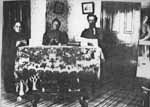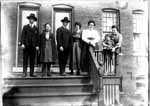Pullman Goes to War -- PCE(R) 852
You are at Home -> The People of Pullman -> Pullman Goes to War -- PCE(R) 852The story of Pullman-built Patrol Craft Escort (Rescue) [PCE(R)] vessel 852
Inspired by the success of the British and Canadian built Corvettes against the U-boat menace in the early days of WWII, the United States decided to build a similar type of small, nimble ship designated PCE (Patrol Craft Escort). Conceived for convoy escort duty, these stubby vessels adapted from steel minesweeper hulls had an overall length of 184 feet, a 33 foot beam, and twin Diesel engines with a top speed under 17 knots. Further consideration as to what their purpose would be after reaching a war zone resulted in several of them being outfitted for an important secondary mission. Added were a sickbay with some 75 bunks stacked three high, a tiny pharmacy, an 8 foot square operating room, and an Xray darkroom. Staffing this medical facility were a doctor and up to ten Pharmacist.s Mates (Hospital Corpsmen). These ships. additional mission was designated .Rescue,. and they became PCE(R)s. Their task would be to go in close to shore of a battle zone, taking advantage of their shallow draft of less than ten feet. There they would pick up casualties from the battlefield, provide immediate medical treatment, and transfer them further offshore to hospital ships or other major vessels with large hospital spaces. Although the PCE(R)s were small floating field hospitals, they were impressive fighting ships as well, bristling with armament topside. This included a 3.150 caliber dual purpose gun, hedgehog anti-submarine rockets, six 20mm anti-aircraft guns, two 40mm guns, and depth charge launchers. Typical of these ships were the USS PCE(R)-851, 852, and 853 built by the Pullman Standard Manufacturing Company in Chicago and commissioned in mid 1944. Manned by a crew of some 90 enlisted and 10 officers, the three ships reached the Philippines together in late October 1944, just in time to participate in the invasion of Leyte. When the PCE(R)s arrived, senior naval commanders were not even familiar with their purpose or medical capabilities. However, before long, they did not have to look for work. During the next month the doctor and medical crew of the 852 received on board, treated, and transferred approximately 400 casualties from the Leyte campaign. Alfred Samuels, a Pharmacist Mate and member of the original crew, now living in Charlottesville, Virginia, summarized the ship.s activities. .The PCE(R)-8S2 went to the rescue of ships crashed by the Japanese Kamikazes, treated wounded from every branch of the services brought Out from the invasion beaches or pulled out of a blazing oil covered ocean, fought off attacking Japanese planes, escorted invasion convoys, and dropped depth charges on suspected Japanese submarines.. Thus was the life of the ship.s crew from Leyte Gulf, on to the invasion of Luzon at Lingayen Gulf and, eventually, Okinawa. The ship.s doctor, LTJG Raymond R. Malott, now a retired physician living in Scottsdale, Arizona, was awarded the Bronze Star for his involvement in going to the rescue of 26 different ships attacked by Kamikazes during the battle for Okinawa. Called to active duty in the midst of his physician.s internship, he led his medical personnel in caring for 200 critically wounded men and over 1000 survivors from these damaged vessels. This involved his going aboard burning and sinking ships to render treatment and to direct evacuation of the wounded. The ship.s regular crew supported these exploits by spending long hours at general quarters fighting off enemy aircraft and often bringing the ship alongside much larger vessels whose gunwales towered over the tiny ship.s bobbing superstructure. Casualties sometimes had to be carried across narrow planks precariously jury-rigged between the two ships of incompatible heights rising and falling at different rates in rough seas. The PCE(R)-852 handled over 1300 casualties on board in less than ten months. After war.s end in August 1945, she and several of her sister ships returned to the East Coast and had all their armament removed. The hospital facilities were converted to work spaces. The term, .Experimental. was added to their designation and they became E-PCE(R)s. In the early 1950.s these ships were given names in addition to their hull numbers. The 852 became the USS Brattleboro, named after the Vermont town. And so, they operated during some 20 years from the Navy.s Underwater Sound Laboratory in New London, Connecticut testing various experimental communications and sonar equipment. In 1966, the 852 was overhauled and transferred to the South Vietnamese Navy to conduct patrols in the South China Sea as the NGOC HOI (HQ-12). When Saigon fell, the ship and her crew escaped to the Philippines. In 1976, she again underwent extensive overhaul, was re-fitted with modern armament, and became BRP MIGUEL MALVAR (PS-19) of the Philippine Navy, where she has served with distinction ever since. In recent months, she has been at the center of extensive naval combat operations against terrorists in Southern Mindanao. The recipient of many decorations, this resilient little craft was named Ship of the Year in 2001, and is today the most decorated vessel in the Philippine Navy. Martin J. HacalaCAPT USNR(Ret)
More Information About the People of Pullman
The People of Pullman
The Pullman House History Project



